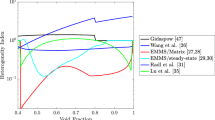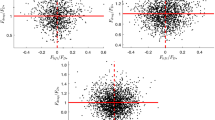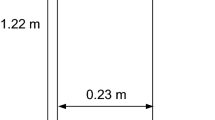Abstract
Several methods are employed for drag force calculations with the discrete element method depending on the desired accuracy and the number of particles involved. For many applications, the fluid motion cannot be solved at the pore scale due to the heavy computational cost. Instead, the coarse-grid method (CGM) is often used. It involves solving an averaged form of the Navier–Stokes equations at the continuum scale and distributing the total drag force among the particles. For monodisperse assemblages, the total drag force can be uniformly distributed among the particles. For polydisperse assemblages, however, the total CGM drag force must be weighted. It can be applied proportionally to the volume (CGM-V) or surface (CGM-S) of each particle. This article compares the CGM-V and CGM-S weighting methods with the weighting obtained by solving the Navier–Stokes equations at the pore scale with the finite element method (FEM). Three unit cells (simple cubic, body-centered cubic and face-centered cubic) corresponding to different porosity values, (respectively, 0.477, 0.319 and 0.259) were simulated. Each unit cell involved a skeleton of large particles and a smaller particle with variable size and position. It was found that both the CGM-V and CGM-S weighting methods do not generally give accurate drag force values for the smaller particles in a polydisperse assemblage, especially for large-size ratios. An artificial neural network (ANN) was trained using the FEM drag force as the target data to predict the drag force on smaller particles in a granular skeleton. The trained ANN showed a very good agreement with the FEM results, thus presenting ANN as a possible avenue to improve drag force weighting for the coarse-grid method.











Similar content being viewed by others
References
Beetstra, R., van der Hoef, M.A., Kuipers, J.: Drag force of intermediate Reynolds number flow past mono-and bidisperse arrays of spheres. AIChE J. 53, 489–501 (2007)
Brinkman, H.: A calculation of the viscous force exerted by a flowing fluid on a dense swarm of particles. Flow Turbul. Combust. 1, 27 (1949)
Chapuis, R.P., Aubertin, M.: On the use of the Kozeny–Carman equation to predict the hydraulic conductivity of soils. Can. Geotech. J. 40, 616–628 (2003)
Chareyre, B., Cortis, A., Catalano, E., Barthélemy, E.: Pore-scale modeling of viscous flow and induced forces in dense sphere packings. Transp. Porous Media 94, 595–615 (2012)
COMSOL: COMSOL Multiphysics. Version 5.3a (2017)
Cook, B., Lee, M., DiGiovanni, A., Bronowski, D., Perkins, E., Williams, J.: Discrete element modeling applied to laboratory simulation of near-wellbore mechanics. Int. J. Geomech. 4, 19–27 (2004)
Cundall, P.A., Strack, O.D.: A discrete numerical model for granular assemblies. Geotechnique 29, 47–65 (1979)
Darcy, H.: Les fontaines publiques de la ville de Dijon: exposition et application. Victor Dalmont, Paris (1856)
Di Felice, R.: The voidage function for fluid–particle interaction systems. Int. J. Multiph. Flow 20, 153–159 (1994)
Ergun, S.: Fluid flow through packed columns. Chem. Eng. Prog. 48, 89–94 (1952)
Esteghamatian, A., Bernard, M., Lance, M., Hammouti, A., Wachs, A.: Micro/meso simulation of a fluidized bed in a homogeneous bubbling regime. Int. J. Multiph. Flow 92, 93–111 (2017)
Goodarzi, M., Kwok, C.Y., Tham, L.G.: A continuum–discrete model using Darcy’s law: formulation and verification. Int. J. Numer. Anal. Meth. Geomech. 39, 327–342 (2015)
Hagan, M.T., Menhaj, M.B.: Training feedforward networks with the Marquardt algorithm. IEEE Trans. Neural Netw. 5, 989–993 (1994)
Hill, R.J., Koch, D.L., Ladd, A.J.: The first effects of fluid inertia on flows in ordered and random arrays of spheres. J. Fluid Mech. 448, 213–241 (2001)
Holmes, D.W., Williams, J.R., Tilke, P.: Smooth particle hydrodynamics simulations of low Reynolds number flows through porous media. Int. J. Numer. Anal. Meth. Geomech. 35, 419–437 (2011)
Huilin, L., Gidaspow, D.: Hydrodynamics of binary fluidization in a riser: CFD simulation using two granular temperatures. Chem. Eng. Sci. 58, 3777–3792 (2003)
Itasca, P.D.: PFC3D (particle flow code in 3 dimensions) manual. In: ICG (ed.), Minneapolis (2004)
Kafui, K., Thornton, C., Adams, M.: Discrete particle–continuum fluid modelling of gas–solid fluidised beds. Chem. Eng. Sci. 57, 2395–2410 (2002)
Karn, U.: A Quick introduction to neural networks. https://ujjwalkarn.me/2016/08/09/quick-intro-neural-networks/ (2016). Accessed 1 Nov 2018
Kriebitzsch, S., Van der Hoef, M., Kuipers, J.: Fully resolved simulation of a gas-fluidized bed: a critical test of DEM models. Chem. Eng. Sci. 91, 1–4 (2013)
Levenberg, K.: A method for the solution of certain non-linear problems in least squares. Q. Appl. Math. 2, 164–168 (1944)
Liu, M., Liu, G.: Smoothed particle hydrodynamics (SPH): an overview and recent developments. Arch. Comput. Methods Eng. 17, 25–76 (2010)
Lominé, F., Scholtès, L., Sibille, L., Poullain, P.: Modeling of fluid–solid interaction in granular media with coupled lattice Boltzmann/discrete element methods: application to piping erosion. Int. J. Numer. Anal. Meth. Geomech. 37, 577–596 (2013)
Marquardt, D.W.: An algorithm for least-squares estimation of nonlinear parameters. J. Soc. Ind. Appl. Math. 11, 431–441 (1963)
Narsilio, G.A., Buzzi, O., Fityus, S., Yun, T.S., Smith, D.W.: Upscaling of Navier–Stokes equations in porous media: theoretical, numerical and experimental approach. Comput. Geotech. 36, 1200–1206 (2009)
Nawi, N.M., Khan, A., Rehman, M.Z.: A new back-propagation neural network optimized with cuckoo search algorithm. In: International Conference on Computational Science and Its Applications, pp. 413–426. Springer (2013)
O’Sullivan, C.: Advancing geomechanics using DEM. In: International Symposium on Geomechanics from Micro to Macro, IS-Cambridge 2014, 1 September 2014–3 September 2014, pp. 21–32. Taylor and Francis, Cambridge (2015)
Pirnia, P., Duhaime, F., Ethier, Y., Dubé, J.-S.: ICY: an interface between COMSOL multiphysics and discrete element code YADE for the modelling of porous media. Comput. Geosci. 123, 38–46 (2019)
Roache, P.J.: Quantification of uncertainty in computational fluid dynamics. Annu. Rev. Fluid Mech. 29, 123–160 (1997)
Rubinstein, G.J., Derksen, J., Sundaresan, S.: Lattice Boltzmann simulations of low-Reynolds-number flow past fluidized spheres: effect of Stokes number on drag force. J. Fluid Mech. 788, 576–601 (2016)
Tsuji, Y., Kawaguchi, T., Tanaka, T.: Discrete particle simulation of two-dimensional fluidized bed. Powder Technol. 77, 79–87 (1993)
Wen, C.Y.: Mechanics of fluidization. In: Chemical Engineering Progress Symposium Series, pp. 100–111 (1966)
Whitaker, S.: Flow in porous media I: a theoretical derivation of Darcy’s law. Transp. Porous Media 1, 3–25 (1986)
Zeghal, M., El Shamy, U.: A continuum-discrete hydromechanical analysis of granular deposit liquefaction. Int. J. Numer. Anal. Meth. Geomech. 28, 1361–1383 (2004)
Zhang, D.-M., Gao, C.-P., Yin, Z.-Y.: CFD–DEM modeling of seepage erosion around shield tunnels. Tunn. Undergr. Space Technol. 83, 60–72 (2019)
Zhu, H., Zhou, Z., Yang, R., Yu, A.: Discrete particle simulation of particulate systems: theoretical developments. Chem. Eng. Sci. 62, 3378–3396 (2007)
Acknowledgements
The authors gratefully acknowledge the support of Hydro-Québec and NSERC for this project, and the helpful comments of one reviewer.
Author information
Authors and Affiliations
Contributions
PP developed the theory, calculated the drag forces and created the artificial neural network. He wrote the paper. FD developed the theory and supervised the project. He also revised and improved the manuscript. YE reviewed and edited the manuscript. JSD reviewed and edited the manuscript.
Corresponding author
Additional information
Publisher's Note
Springer Nature remains neutral with regard to jurisdictional claims in published maps and institutional affiliations.
Rights and permissions
About this article
Cite this article
Pirnia, P., Duhaime, F., Ethier, Y. et al. Drag Force Calculations in Polydisperse DEM Simulations with the Coarse-Grid Method: Influence of the Weighting Method and Improved Predictions Through Artificial Neural Networks. Transp Porous Med 129, 837–853 (2019). https://doi.org/10.1007/s11242-019-01308-9
Received:
Accepted:
Published:
Issue Date:
DOI: https://doi.org/10.1007/s11242-019-01308-9




